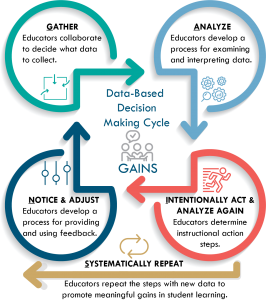OVERVIEW OF ESSENTIAL FUNCTION 2: ANALYZING DATA
| EF 2 and GAINS Step 2 | Actions |
|---|---|
| Educators implement a process for examining and interpreting data = Analyze. | Develop a purposeful data analysis system.
Identify a common problem and relate it to a learning goal or target. Predict a link to teacher practice. |
Developing a Purposeful Data Analysis System
After your team selects what data to analyze, the next decision is how your team will analyze the data. By establishing a system, teams can be efficient when looking at data. Three important elements need to be considered:
- meeting guidelines,
- a meeting protocol, and
- a meeting agenda.
Meeting Guidelines
Setting meeting guidelines helps teams focus on their goal and shared values. Meeting guidelines should be
- Individualized to the group.
- Overarching thoughts and considerations about how the team will approach the data.
- Approached differently from norms, which address basic codes of behavior.
Guiding Questions
- What do we expect students to learn?
- How will we know students are learning?
- How will we respond to students who are not learning?
Sample Meeting Guidelines
- We value student outcomes as important for improving achievement.
- We are accountable for evaluating and modifying our instructional practices in ways that meet students’ needs based on the data.
- We work collaboratively because we know it helps us to better understand our students’ learning needs.
Meeting Protocols
Sample Data Meeting Agenda/Protocol
Meeting Agenda
A meeting agenda outlines the flow and goals of the meeting. A meeting agenda should
- Keep the team on track during the meeting.
- Include talking points.
- Address team questions.
- Be collaboratively developed.
- Be accessible to team members prior to the meeting.
- Change from meeting to meeting (guidelines and protocols generally do not change from meeting to meeting).
Review the Sample Meeting Guidelines (https://www.moedu-sail.org/wp-content/uploads/2019/02/DBDM-Workbook_Sample_Meeting_Guidelines-2019.pdf), Protocol and Agenda Handout (https://www.moedu-sail.org/wp-content/uploads/2019/02/DBDM-Workbook_Sample_Meeting_Protocol-2019.pdf), and reflect on the strengths and needs of your teams’ current Data Analysis System.


